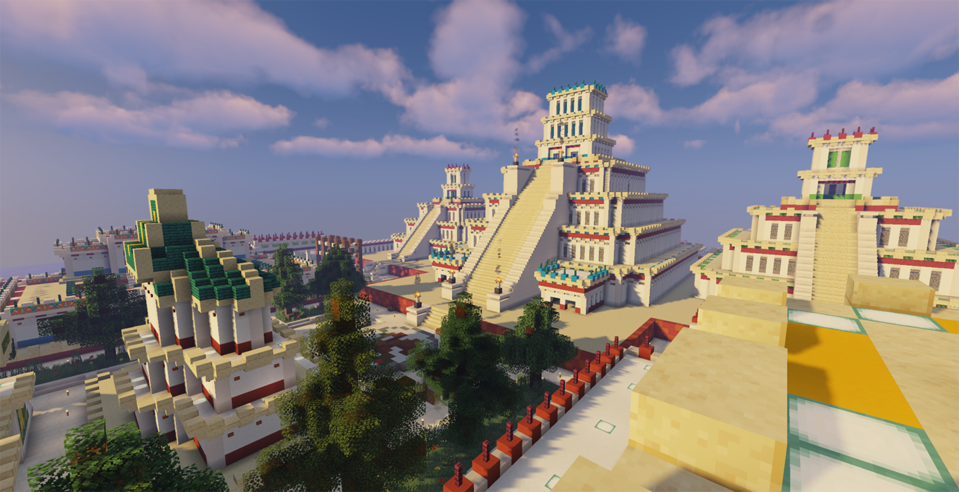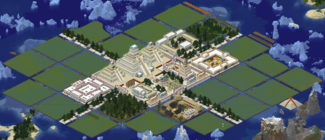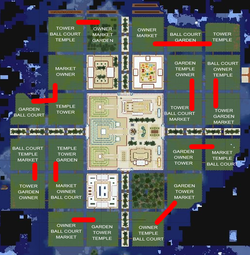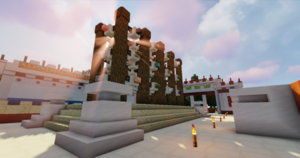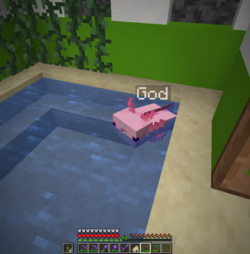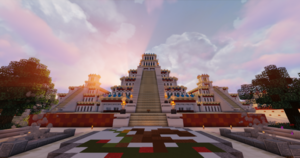Tepēcetlan: Difference between revisions
(Added lore section and some additional pictures.) |
abruptfern (talk | contribs) m (Added Nav and category boxes.) Tag: 2017 source edit |
||
| (18 intermediate revisions by one other user not shown) | |||
| Line 2: | Line 2: | ||
Tepēcetlan is a large personal base | |||
Tepēcetlan is a large personal base inspired by the capitol of the Aztec empire - Tenōchtitlan. SeñorKevin, the creator of the city, went to great lengths to replicate elements of the real-world counterpart while still making it distinct. The city is made up of a series of flat islands in an ocean and is surrounded by glaciers. This location gave the city it's name, which translates to "the place among the ice mountains" in Nahuatl - the language of the Aztecs. | |||
Throughout the build, there are many canals and elaborate tree-covered walkways used for travel between the several islands. These islands house a large central religious plaza, a king's palace, a market square, a zoo, a botanical garden, farms, and villages. In the plaza and villages especially, there are many intriguing smaller builds, such as temples, skull racks, schoolhouses, ball courts, and more. | Throughout the build, there are many canals and elaborate tree-covered walkways used for travel between the several islands. These islands house a large central religious plaza, a king's palace, a market square, a zoo, a botanical garden, farms, and villages. In the plaza and villages especially, there are many intriguing smaller builds, such as temples, skull racks, schoolhouses, ball courts, and more. | ||
| Line 8: | Line 9: | ||
| name = Tepēcetlan | | name = Tepēcetlan | ||
| image = Tepēcetlan 3-6-22.png | | image = Tepēcetlan 3-6-22.png | ||
| coordinates = | | coordinates = 2903, 3644 | ||
| world = 1.16 Survival Overworld | | world = 1.16 Survival Overworld | ||
| dynmap = https://minecraft.rtgame.co.uk/map/survival#world; | | dynmap = https://minecraft.rtgame.co.uk/map/survival#world;flat;2903,64,3644;9 | ||
| creator = SeñorKevin | | creator = SeñorKevin | ||
| status = Under construction | | status = Under construction | ||
| Line 19: | Line 20: | ||
SeñorKevin wanted to recreate Tenōchtitlan in survival for quite some time, but didn't find a good opportunity to until the 1.16 server update. He quickly began looking around dynamap, trying to find an island or area of ocean suitable for habitation. The island he wanted initially was the one where Birthday Island is currently located, but when asked by WhimsyBridges to relocate, he complied and sailed east until he landed on another suitable island. | SeñorKevin wanted to recreate Tenōchtitlan in survival for quite some time, but didn't find a good opportunity to until the 1.16 server update. He quickly began looking around dynamap, trying to find an island or area of ocean suitable for habitation. The island he wanted initially was the one where Birthday Island is currently located, but when asked by WhimsyBridges to relocate, he complied and sailed east until he landed on another suitable island. | ||
At this time, the island was covered in spruce | At this time, the island was covered in spruce forests and mountains. SeñorKevin decided he needed to flatten the large island before constructing the city, reasoning that the large landmass would help him scale the city properly and assist with planning. This was a questionable decision; the excavation process took months to complete. | ||
Several prominent buildings within Tenochtitlan would | With a completely flat landmass, planning could begin. The city was to be laid out in a cross shape, with paths running north-south and east-west, dividing the city into four corners. These paths would lead to a central religious plaza. Then, all four corners would be divided into smaller islands, with some housing important government and societal buildings/locations and others housing villages where civilians would live. [[File:Map-tepecetlan.png|thumb|Map of Tepēcetlan, showing the layout of districts.|255x255px]]Several prominent buildings within Tenochtitlan would be recreated or approximated within the city. These include prominent temples in the religious plaza, the king's palace, at least one botanical garden, a zoo, and a market square. These were placed directly next to the main plaza, either to the north or south, with the reasoning being that such important buildings should face east or west so they may see the sun and moon. However, there was still the issues of the villages. | ||
The villages were to be broken up into smaller districts, each of which would contain many smaller elements that would be required for governance and decent quality of life for the residents. These included homes, "towers" (poles on which the Danza de los Voladores could be performed), owner/governor's palace, small markets, small public gardens, ball courts (on which Mesoamerican Ball Game could be played), small temples for worship, and schoolhouses. | The villages were to be broken up into smaller districts, each of which would contain many smaller elements that would be required for governance and decent quality of life for the residents. These included homes, "towers" (poles on which the Danza de los Voladores could be performed), owner/governor's palace, small markets, small public gardens, ball courts (on which Mesoamerican Ball Game could be played), small temples for worship, and schoolhouses. | ||
== Notable Locations == | == Notable Locations == | ||
Tepēcetlan contains a number of important and distinct islands/locations: | Tepēcetlan contains a number of important and distinct islands/locations: | ||
| Line 37: | Line 30: | ||
Located in the center of the city, the religious plaza contains religious temples. At time of writing, there are temples dedicated to Tlaloc, Quetzalcoatl, Huehuecoyotl, Xolotl, Tezcatlipoca, Opochtli, Yacatecuhtli, and Mictlantecutli. There are also temples without an associated god. | Located in the center of the city, the religious plaza contains religious temples. At time of writing, there are temples dedicated to Tlaloc, Quetzalcoatl, Huehuecoyotl, Xolotl, Tezcatlipoca, Opochtli, Yacatecuhtli, and Mictlantecutli. There are also temples without an associated god. | ||
Some temples serve double duty as places of worship and as some other important societal | Some temples serve double duty as places of worship and as some other important societal buildings. Quetzalcoatl 's temple is a bathhouse, Tezcatlipoca's temple is a schoolhouse, Yacatecuhtli's temple has a nether portal, and Xolotl's temple houses God - a pink axolotl. | ||
There are a few other buildings and notable features in the plaza. | There are a few other buildings and notable features in the plaza. | ||
* There is a large disk on the ground near Yacatecuhtli's temple with the image of an eagle atop a nopal cactus eating a snake. This a reference to the Aztec story of the founding of Tenōchtitlan; the Aztecs traveled far south into central Mexico and saw this event taking place on an island in Lake Texcoco (currently Mexico City.) They believed this was a sign from the gods | * There is a large disk on the ground near Yacatecuhtli's temple with the image of an eagle atop a nopal cactus eating a snake. This a reference to the Aztec story of the founding of Tenōchtitlan; the Aztecs traveled far south into central Mexico and saw this event taking place on an island in Lake Texcoco (currently Mexico City.) They believed this was a sign from the gods. telling them this was the place where they must construct their empire. | ||
* There is a small ball court. This court is modeled after those used in Mesoamerican Ball game, a game similar to soccer, basketball, and volleyball.[[File:Skull-rack.png|thumb|Tepēcetlan's skull rack.]] | * There is a small ball court. This court is modeled after those used in Mesoamerican Ball game, a game similar to soccer, basketball, and volleyball.[[File:Skull-rack.png|thumb|Tepēcetlan's skull rack.]] | ||
* There is a skull rack containing the heads of several mobs and animals. This is a reference to the skull racks prominently displayed in Tenōchtitlan, which were likely used to scare political enemies and potential criminals. | * There is a skull rack containing the heads of several mobs and animals. This is a reference to the skull racks prominently displayed in Tenōchtitlan, which were likely used to scare political enemies and potential criminals. | ||
| Line 83: | Line 76: | ||
The botanical garden is located south of the religious plaza and directly across the walkway from the zoo. It is a terraformed island and, as a result, is the only part of the city that is not flat. The land is formed into four hills which form a valley in the center. In this valley, there is a small pond containing an axolotl. The entire garden is covered in custom trees along with grass, flowers, bamboo, and other plant life. | The botanical garden is located south of the religious plaza and directly across the walkway from the zoo. It is a terraformed island and, as a result, is the only part of the city that is not flat. The land is formed into four hills which form a valley in the center. In this valley, there is a small pond containing an axolotl. The entire garden is covered in custom trees along with grass, flowers, bamboo, and other plant life. | ||
The garden is built in a naturalistic way, allowing many plants to grow together and not relying on separate flower/plant | The garden is built in a naturalistic way, allowing many plants to grow together and not relying on separate flower/plant beds. This was done to reflect the idea of Tlalocan - the Aztec "heaven" where people who died from water went to. Aztec gardens were said to mimic Tlalocan, Tlalocan is described as a natural paradise, and so the choice was made to have the land be organic. | ||
==== Villages ==== | ==== Villages ==== | ||
Villages contain many elements meant to meet human needs and reflect the districting system present in Tenōchtitlan. Every village contains at least two islands, and across these two islands there are a few necessary buildings. Every district needs at least one of each of these things: | Villages contain many elements meant to meet human needs and reflect the districting system present in Tenōchtitlan. Every village contains at least two islands, and across these two islands, there are a few necessary buildings. Every district needs at least one of each of these things: | ||
* Owner/governor's house | * Owner/governor's house | ||
| Line 103: | Line 96: | ||
==== Worldbuilding ==== | ==== Worldbuilding ==== | ||
Most of the world and mythology created for Tepēcetlan is identical to that of the Aztecs. However, there are some small changes made to the religion and lifestyle that tie back to the city's climate and the fact that it's in Minecraft. | Most of the world and mythology created for Tepēcetlan is identical to that of the Aztecs. However, there are some small changes made to the religion and lifestyle that tie back to the city's climate and the fact that it's in Minecraft. [[File:God-the-axolotl.png|thumb|God the axolotl in his home.|254x254px]] | ||
* Residents get clean water by melting ice from nearby glaciers. This is evidenced in the plaza by large containers for water sitting above campfires. | * Residents get clean water by melting ice from nearby glaciers. This is evidenced in the plaza by large containers for water sitting above campfires. | ||
* The main god of Tepēcetlan is Tlaloc, the god of water. | * The main god of Tepēcetlan is Tlaloc, the god of water. | ||
* While human sacrifice is practiced, the reasoning is more applicable to Minecraft. EXP orbs give the gods the energy to keep the universe alive rather than blood. | * While human sacrifice is practiced, the reasoning is more applicable to Minecraft. EXP orbs give the gods the energy to keep the universe alive rather than blood. | ||
* It is believed that, while Tlaloc is the main god that is worshiped, God the axolotl - resident of Xolotl's temple - is an incredibly important being. If he isn't the being that controls all things, he at least looks after all the animals of the world. This is evidenced by the fact that Xolotl calls for the sacrifice of all people who kill dogs, axolotls, and/or excessive numbers of other animals. | * It is believed that, while Tlaloc is the main god that is worshiped, God the axolotl - resident of Xolotl's temple - is an incredibly important being. If he isn't the being that controls all things, he at least looks after all the animals of the world. This is evidenced by the fact that Xolotl calls for the sacrifice of all people who kill dogs, axolotls, and/or excessive numbers of other animals. | ||
[[File:Main-temples.png|thumb|The large, blue temple in the center is Tlaloc's. All sacrifices are performed here.]] | |||
==== Sacrifice ==== | ==== Sacrifice ==== | ||
Sacrifice is an accepted part of Tepēcetlan and these sacrifices are somewhat popular within the survival server's community. These sacrifices occur for several different reasons, usually because someone wants to be sacrificed, wants to PvP, or has killed an animal. All sacrifices occur on the top level of Tlaloc's temple which is a PvP area. | Sacrifice is an accepted part of Tepēcetlan and these sacrifices are somewhat popular within the survival server's community. These sacrifices occur for several different reasons, usually because someone wants to be sacrificed, wants to PvP, or has killed an animal. All sacrifices occur on the top level of Tlaloc's temple which is a PvP area. | ||
There are two outcomes of sacrifice - cleansing someone of a perceived wrongdoing or becoming a manifestation of a god. If someone has done something wrong and is called to be sacrificed, their sacrifice will fuel the gods and cleanse that person of their sins. If someone has not done anything wrong but opts to be sacrificed, they will become a manifestation of a god of their choosing. Also, these people may choose to claim a temple or structure within the city. For | There are two outcomes of sacrifice - cleansing someone of a perceived wrongdoing or becoming a manifestation of a god. If someone has done something wrong and is called to be sacrificed, their sacrifice will fuel the gods and cleanse that person of their sins. If someone has not done anything wrong but opts to be sacrificed, they will become a manifestation of a god of their choosing. Also, these people may choose to claim a temple or structure within the city. For example, WhimsyBridges is a manifestation of Xipe Totec and opted to claim a bridge in the city. | ||
Typically, sacrifices are performed by SeñorKevin using a sword named "Macuahuitl" after the Aztec weapon of the same name. All sacrifices must be initiated with the phrase "in xochitl, in cuicatl" in order for them to be accepted by the gods. | Typically, sacrifices are performed by SeñorKevin using a sword named "Macuahuitl" after the Aztec weapon of the same name. All sacrifices must be initiated with the phrase "in xochitl, in cuicatl" in order for them to be accepted by the gods. | ||
== Construction, Materials, and Assistance == | == Construction, Materials, and Assistance == | ||
Construction of Tepēcetlan has been going on since the first month of the 1.16 survival server, whether it be flattening the island, digging canals, or constructing buildings. Although construction is ongoing, many of the most important structures have been completed | Construction of Tepēcetlan has been going on since the first month of the 1.16 survival server, whether it be flattening the island, digging canals, or constructing buildings. Although construction is ongoing, many of the most important structures have been completed. Only the villages and outer farms need to be done. | ||
Most of the societally important buildings are made of mixes of snow, smooth quartz, terracotta/concrete, and sandstone of several varieties. The amount of quartz used in Tepēcetlan is often a source of awe for visitors, as is the use of bone blocks in the ground of the plaza and the main walkways. | Most of the societally important buildings are made of mixes of snow, smooth quartz, terracotta/concrete, and sandstone of several varieties. The amount of quartz used in Tepēcetlan is often a source of awe for visitors, as is the use of bone blocks in the ground of the plaza and the main walkways. | ||
Villages are mostly made of several wood and terracotta varieties, reflecting the materials that Aztec commoners had access to. However, some buildings reflect the opulence of the societally important structures. For instance, the homes of the owners/ | Villages are mostly made of several wood and terracotta varieties, reflecting the materials that Aztec commoners had access to. However, some buildings reflect the opulence of the societally important structures. For instance, the homes of the owners/governors of each district are effectively small versions of the king's palace. They are made of quartz, snow, sandstone, and terracotta/concrete. | ||
Although all construction was done by SeñorKevin, material donations from the community have been and continue to be frequent. Notable contributors are Orca_Bird (sandstone), tnebert (quartz), LonkReborn (quartz), and G0rd0nFreeman (quartz). | |||
{{1.16 Nav}} | |||
[[Category:1.16 (2021) Server]] | |||
[[Category:1.16 (2021) Points of Interest]] | |||
[[Category:Points of Interest]] | |||
Latest revision as of 05:18, 17 March 2022
Tepēcetlan is a large personal base inspired by the capitol of the Aztec empire - Tenōchtitlan. SeñorKevin, the creator of the city, went to great lengths to replicate elements of the real-world counterpart while still making it distinct. The city is made up of a series of flat islands in an ocean and is surrounded by glaciers. This location gave the city it's name, which translates to "the place among the ice mountains" in Nahuatl - the language of the Aztecs.
Throughout the build, there are many canals and elaborate tree-covered walkways used for travel between the several islands. These islands house a large central religious plaza, a king's palace, a market square, a zoo, a botanical garden, farms, and villages. In the plaza and villages especially, there are many intriguing smaller builds, such as temples, skull racks, schoolhouses, ball courts, and more.
| Collapse | |
| Tepēcetlan | |
|---|---|
| Creator(s) | SeñorKevin |
| Status | Under construction |
| Location | |
| Coordinates | 2903, 3644 |
| World | 1.16 Survival Overworld |
| Nether Path | Blue path, right, quartz pillar and white glazed terracotta. |
| Dynmap Link | |
Early Days and Planning
SeñorKevin wanted to recreate Tenōchtitlan in survival for quite some time, but didn't find a good opportunity to until the 1.16 server update. He quickly began looking around dynamap, trying to find an island or area of ocean suitable for habitation. The island he wanted initially was the one where Birthday Island is currently located, but when asked by WhimsyBridges to relocate, he complied and sailed east until he landed on another suitable island.
At this time, the island was covered in spruce forests and mountains. SeñorKevin decided he needed to flatten the large island before constructing the city, reasoning that the large landmass would help him scale the city properly and assist with planning. This was a questionable decision; the excavation process took months to complete.
With a completely flat landmass, planning could begin. The city was to be laid out in a cross shape, with paths running north-south and east-west, dividing the city into four corners. These paths would lead to a central religious plaza. Then, all four corners would be divided into smaller islands, with some housing important government and societal buildings/locations and others housing villages where civilians would live.
Several prominent buildings within Tenochtitlan would be recreated or approximated within the city. These include prominent temples in the religious plaza, the king's palace, at least one botanical garden, a zoo, and a market square. These were placed directly next to the main plaza, either to the north or south, with the reasoning being that such important buildings should face east or west so they may see the sun and moon. However, there was still the issues of the villages.
The villages were to be broken up into smaller districts, each of which would contain many smaller elements that would be required for governance and decent quality of life for the residents. These included homes, "towers" (poles on which the Danza de los Voladores could be performed), owner/governor's palace, small markets, small public gardens, ball courts (on which Mesoamerican Ball Game could be played), small temples for worship, and schoolhouses.
Notable Locations
Tepēcetlan contains a number of important and distinct islands/locations:
Religious Plaza
Located in the center of the city, the religious plaza contains religious temples. At time of writing, there are temples dedicated to Tlaloc, Quetzalcoatl, Huehuecoyotl, Xolotl, Tezcatlipoca, Opochtli, Yacatecuhtli, and Mictlantecutli. There are also temples without an associated god.
Some temples serve double duty as places of worship and as some other important societal buildings. Quetzalcoatl 's temple is a bathhouse, Tezcatlipoca's temple is a schoolhouse, Yacatecuhtli's temple has a nether portal, and Xolotl's temple houses God - a pink axolotl.
There are a few other buildings and notable features in the plaza.
- There is a large disk on the ground near Yacatecuhtli's temple with the image of an eagle atop a nopal cactus eating a snake. This a reference to the Aztec story of the founding of Tenōchtitlan; the Aztecs traveled far south into central Mexico and saw this event taking place on an island in Lake Texcoco (currently Mexico City.) They believed this was a sign from the gods. telling them this was the place where they must construct their empire.
- There is a small ball court. This court is modeled after those used in Mesoamerican Ball game, a game similar to soccer, basketball, and volleyball.
- There is a skull rack containing the heads of several mobs and animals. This is a reference to the skull racks prominently displayed in Tenōchtitlan, which were likely used to scare political enemies and potential criminals.
- Some of the lighting in the city is mounted on netherite blocks. This is done to show wealth, as was done in Tenōchtitlan with gold and gems, as well as elaborate patterns and building construction.
King's Palace
The "king" (SeñorKevin), known as the Huey Tlatoani, lives in a palace directly north of the religious plaza. Compared to the other homes in the city, the palace is quite extravagant. It has two floors, 22 rooms, a private garden, and is made of expensive materials.
Market Square
The market square is located north of the religious plaza and is directly across the walkway from the king's palace. This square contains many tents and rooms where trade would be done.
Zoo
The zoo is located south of the religious plaza. It houses many animals native to taiga and frozen ocean biomes, although there are exotic animals as well.
The following animals are present in the zoo:
(Semi)Aquatic
- Axolotls (all colors)
- Tropical Fish (exact variants not known)
- Turtles
Air
- Parrots (three colors)
Land
- Polar Bears*
- Llamas
- Pigs
- Foxes
- Wolves
- Sheep
- Cows
- Chickens
* = Incomplete exhibit at time of writing.
Botanical Garden
The botanical garden is located south of the religious plaza and directly across the walkway from the zoo. It is a terraformed island and, as a result, is the only part of the city that is not flat. The land is formed into four hills which form a valley in the center. In this valley, there is a small pond containing an axolotl. The entire garden is covered in custom trees along with grass, flowers, bamboo, and other plant life.
The garden is built in a naturalistic way, allowing many plants to grow together and not relying on separate flower/plant beds. This was done to reflect the idea of Tlalocan - the Aztec "heaven" where people who died from water went to. Aztec gardens were said to mimic Tlalocan, Tlalocan is described as a natural paradise, and so the choice was made to have the land be organic.
Villages
Villages contain many elements meant to meet human needs and reflect the districting system present in Tenōchtitlan. Every village contains at least two islands, and across these two islands, there are a few necessary buildings. Every district needs at least one of each of these things:
- Owner/governor's house
- Garden
- "Tower" (pole on which the Danza de los Voladores could be performed)
- Schoolhouse
- Market
- Ball court (for Mesoamerican Ball Game)
- Temple
Every village also contains homes and external decoration that suggests the homeowner's occupation. By far, the most common occupations are farmer, potter/sculptor, and textile worker.
Homes in these villages are quite diverse. While most homes are single-room and single-family, there are many shapes and colors of these along with various roof types. Also, there are complexes of many homes next to one another, including some which have two levels.
Lore
Worldbuilding
Most of the world and mythology created for Tepēcetlan is identical to that of the Aztecs. However, there are some small changes made to the religion and lifestyle that tie back to the city's climate and the fact that it's in Minecraft.
- Residents get clean water by melting ice from nearby glaciers. This is evidenced in the plaza by large containers for water sitting above campfires.
- The main god of Tepēcetlan is Tlaloc, the god of water.
- While human sacrifice is practiced, the reasoning is more applicable to Minecraft. EXP orbs give the gods the energy to keep the universe alive rather than blood.
- It is believed that, while Tlaloc is the main god that is worshiped, God the axolotl - resident of Xolotl's temple - is an incredibly important being. If he isn't the being that controls all things, he at least looks after all the animals of the world. This is evidenced by the fact that Xolotl calls for the sacrifice of all people who kill dogs, axolotls, and/or excessive numbers of other animals.
Sacrifice
Sacrifice is an accepted part of Tepēcetlan and these sacrifices are somewhat popular within the survival server's community. These sacrifices occur for several different reasons, usually because someone wants to be sacrificed, wants to PvP, or has killed an animal. All sacrifices occur on the top level of Tlaloc's temple which is a PvP area.
There are two outcomes of sacrifice - cleansing someone of a perceived wrongdoing or becoming a manifestation of a god. If someone has done something wrong and is called to be sacrificed, their sacrifice will fuel the gods and cleanse that person of their sins. If someone has not done anything wrong but opts to be sacrificed, they will become a manifestation of a god of their choosing. Also, these people may choose to claim a temple or structure within the city. For example, WhimsyBridges is a manifestation of Xipe Totec and opted to claim a bridge in the city.
Typically, sacrifices are performed by SeñorKevin using a sword named "Macuahuitl" after the Aztec weapon of the same name. All sacrifices must be initiated with the phrase "in xochitl, in cuicatl" in order for them to be accepted by the gods.
Construction, Materials, and Assistance
Construction of Tepēcetlan has been going on since the first month of the 1.16 survival server, whether it be flattening the island, digging canals, or constructing buildings. Although construction is ongoing, many of the most important structures have been completed. Only the villages and outer farms need to be done.
Most of the societally important buildings are made of mixes of snow, smooth quartz, terracotta/concrete, and sandstone of several varieties. The amount of quartz used in Tepēcetlan is often a source of awe for visitors, as is the use of bone blocks in the ground of the plaza and the main walkways.
Villages are mostly made of several wood and terracotta varieties, reflecting the materials that Aztec commoners had access to. However, some buildings reflect the opulence of the societally important structures. For instance, the homes of the owners/governors of each district are effectively small versions of the king's palace. They are made of quartz, snow, sandstone, and terracotta/concrete.
Although all construction was done by SeñorKevin, material donations from the community have been and continue to be frequent. Notable contributors are Orca_Bird (sandstone), tnebert (quartz), LonkReborn (quartz), and G0rd0nFreeman (quartz).
